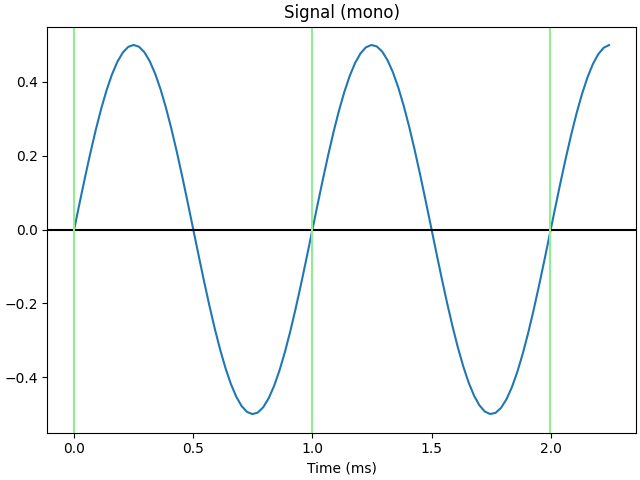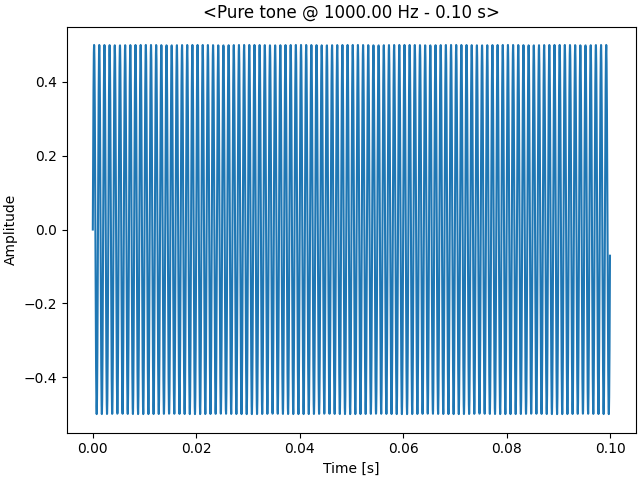Note
Go to the end to download the full example code.
Base sounds🔗
stimuli provides a common API for audio stimuli. The audio
stimuli can be either generated or loaded. A generated stimuli can be exported.
The volume, duration and other properties can be set when creating the stimuli
or updated between plays.
from pathlib import Path
from tempfile import TemporaryDirectory
from matplotlib import pyplot as plt
from stimuli.audio import Sound, Tone
In this tutorial, we will create, edit, save and load a pure tone auditory stimuli. A pure tone is a signal with a sinusoidal waveform, that is a sine wave of any frequency, phase-shift and amplitude.
Source: Wikipedia
Create and edit a pure tone🔗
To create the stimuli, we create a Tone object with
a given volume and frequency.
We can listen to the sound we created with play().
sound.play(blocking=True)
We can edit the sound properties by replacing the value in the properties. For instance, let’s increase the volume and change the frequency.
sound.volume = 50 # percentage between 0 and 100
sound.frequency = 1000 # Hz
The sound is updated each time an attribute is changed.
sound.play(blocking=True)
Export/Load a sound🔗
We can export a sound with save() and load a sound with
Sound.
with TemporaryDirectory() as directory:
fname = Path(directory) / "my_pure_tone.wav"
sound.save(fname, overwrite=True)
sound_loaded = Sound(fname)
sound_loaded.play(blocking=True)
However, a loaded sound can be any type of sound. stimuli does not
know that the sound was exported with the save() method of one of its
class. As such, the attributes that were specific to the original sound are
not present anymore and can not be updated anymore.
print(hasattr(sound_loaded, "frequency"))
False
Only the basic attributes are preserved: duration, sample_rate.
print(f"Duration of the original sound: {sound.duration} second.")
print(f"Duration of the loaded sound: {sound_loaded.duration} second.")
print(f"Sample rate of the original sound: {sound.sample_rate} Hz.")
print(f"Sample rate of the loaded sound: {sound_loaded.sample_rate} Hz.")
Duration of the original sound: 0.1 second.
Duration of the loaded sound: 0.1 second.
Sample rate of the original sound: 44100 Hz.
Sample rate of the loaded sound: 44100 Hz.
The volume is normalized, with the loudest channel set to 100. The ratio
between channels is preserved.
print(f"Volume of the original sound: {sound.volume}.")
print(f"Volume of the loaded sound: {sound_loaded.volume}.")
Volume of the original sound: [50.].
Volume of the loaded sound: [100.].
Visualize a sound🔗
Finally, the underlying signal is stored in the signal property, a numpy array of
shape (n_samples, n_channels). We can plot the signal of each channel.
samples_to_plot = 100 # number of samples to plot
times = sound.times[:samples_to_plot] * 1000 # ms
f, ax = plt.subplots(1, 1, layout="constrained")
ax.plot(times, sound.signal.squeeze()[:samples_to_plot]) # draw data
ax.axhline(0, color="black") # draw horizontal line through y=0
# labels
ax.set_title("Signal (mono)")
ax.set_xlabel("Time (ms)")
# draw vertical line after each period
period = int(sound.sample_rate / sound.frequency)
for k in range(0, samples_to_plot, period):
ax.axvline(times[k], color="lightgreen")
plt.show()

Or with the convenient plot() method.
sound.plot()
plt.show()

Total running time of the script: (0 minutes 19.148 seconds)
Estimated memory usage: 151 MB